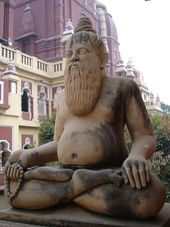Yoga Sutras of Patanjali
Main articles: Raja Yoga and Yoga Sutras of Patanjali
| Pada (Chapter) | English meaning | Sutras |
| Samadhi Pada | On being absorbed in spirit | |
| Sadhana Pada | On being immersed in spirit | |
| Vibhuti Pada | On supernatural abilities and gifts | |
| Kaivalya Pada | On absolute freedom | |
In Hindu philosophy, Yoga is the name of one of the six orthodox philosophical schools.[28][29] The Yoga philosophical system is closely allied with the Samkhya school.[30] The Yoga school as expounded by the sage Patanjali accepts the Samkhya psychology and metaphysics, but is more theistic than the Samkhya, as evidenced by the addition of a divine entity to the Samkhya's twenty-five elements of reality.[31][32] The parallels between Yoga and Samkhya were so close that Max Müller says that "the two philosophies were in popular parlance distinguished from each other as Samkhya with and Samkhya without a Lord...."[33] The intimate relationship between Samkhya and Yoga is explained by Heinrich Zimmer:
These two are regarded in India as twins, the two aspects of a single discipline. Sāṅkhya provides a basic theoretical exposition of human nature, enumerating and defining its elements, analyzing their manner of co-operation in a state of bondage ("bandha"), and describing their state of disentanglement or separation in release ("mokṣa"), while Yoga treats specifically of the dynamics of the process for the disentanglement, and outlines practical techniques for the gaining of release, or "isolation-integration" ("kaivalya").[34]Patanjali is widely regarded as the founder of the formal Yoga philosophy.[35] Patanjali's yoga is known as Raja yoga, which is a system for control of the mind.[36] Patanjali defines the word "yoga" in his second sutra, which is the definitional sutra for his entire work:
योग: चित्त-वृत्ति निरोध:This terse definition hinges on the meaning of three Sanskrit terms. I. K. Taimni translates it as "Yoga is the inhibition (nirodhaḥ) of the modifications (vṛtti) of the mind (citta)".[37] The use of the word nirodhaḥ in the opening definition of yoga is an example of the important role that Buddhist technical terminology and concepts play in the Yoga Sutra; this role suggests that Patanjali was aware of Buddhist ideas and wove them into his system.[38] Swami Vivekananda translates the sutra as "Yoga is restraining the mind-stuff (Citta) from taking various forms (Vrittis)."[39]
(yogaś citta-vṛtti-nirodhaḥ)
- Yoga Sutras 1.2
Patanjali's writing also became the basis for a system referred to as "Ashtanga Yoga" ("Eight-Limbed Yoga"). This eight-limbed concept derived from the 29th Sutra of the 2nd book, and is a core characteristic of practically every Raja yoga variation taught today. The Eight Limbs are:
- Yama (The five "abstentions"): non-violence, non-lying, non-covetousness, non-sensuality, and non-possessiveness.
- Niyama (The five "observances"): purity, contentment, austerity, study, and surrender to god.
- Asana: Literally means "seat", and in Patanjali's Sutras refers to the seated position used for meditation.
- Pranayama ("Suspending Breath"): Prāna, breath, "āyāma", to restrain or stop. Also interpreted as control of the life force.
- Pratyahara ("Abstraction"): Withdrawal of the sense organs from external objects.
- Dharana ("Concentration"): Fixing the attention on a single object.
- Dhyana ("Meditation"): Intense contemplation of the nature of the object of meditation.
- Samādhi ("Liberation"): merging consciousness with the object of meditation.
Yoga and Samkhya
Main article: Samkhya
Patanjali systematized the conceptions of Yoga and set them forth on the background of the metaphysics of Samkhya, which he assumed with slight variations. In the early works, the Yoga principles appear along with the Samkhya ideas. Vyasa's commentary on the Yoga Sutras, also called the “Samkhyapravacanabhasya,” brings out the intimate relation between the two systems.[41]Yoga agrees with the essential metaphysics of Samkhya, but differs from it in that while Samkhya holds that knowledge is the means of liberation, Yoga is a system of active striving, mental discipline, and dutiful action. Yoga also introduces the conception of God. Sometimes Patanjali's system is referred to as “Seshvara Samkhya” in contradistinction to Kapila's "Nirivara Samkhya." [42]
Bhagavad Gita
Main article: Bhagavad Gita
The Bhagavad Gita ('Song of the Lord'), uses the term "yoga" extensively in a variety of ways. In addition to an entire chapter (ch. 6) dedicated to traditional yoga practice, including meditation,[43] it introduces three prominent types of yoga:[44]- Karma yoga: The yoga of action,
- Bhakti yoga: The yoga of devotion,
- Jnana yoga: The yoga of knowledge.

No comments:
Post a Comment